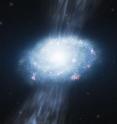Growing galaxies gently
The first galaxies formed before the Universe was less than one billion years old and were much smaller than the giant systems — including the Milky Way — that we see today. So somehow the average galaxy size has increased as the Universe has evolved. Galaxies often collide and then merge to form larger systems and this process is certainly an important growth mechanism. However, an additional, gentler way has been proposed. A European team of astronomers has used ESO's Very Large Telescope to test this very different idea — that young galaxies can also grow by sucking in cool streams of the hydrogen and helium gas that filled the early Universe and forming new stars from this primitive material. Just as a commercial company can expand either by merging with other companies, or by hiring more staff, young galaxies could perhaps also grow in two different ways — by merging with other galaxies or by accreting material.
The team leader, Giovanni Cresci (Osservatorio Astrofisico di Arcetri) says: "The new results from the VLT are the first direct evidence that the accretion of pristine gas really happened and was enough to fuel vigorous star formation and the growth of massive galaxies in the young Universe." The discovery will have a major impact on our understanding of the evolution of the Universe from the Big Bang to the present day. Theories of galaxy formation and evolution may have to be re-written.
The group began by selecting three very distant galaxies to see if they could find evidence of the flow of pristine gas from the surrounding space and the associated formation of new stars. They were very careful to make sure that their specimen galaxies had not been disturbed by interactions with other galaxies. The selected galaxies were very regular, smoothly rotating discs, similar to the Milky Way, and they were seen about two billion years after the Big Bang (at a redshift of around three).
In galaxies in the modern Universe the heavy elements [1] are more abundant close to the centre. But when Cresci's team mapped their selected distant galaxies with the SINFONI spectrograph on the VLT [2] they were excited to see that in all three cases there was a patch of the galaxy, close to the centre, with fewer heavy elements, but hosting vigorously forming stars, suggesting that the material to fuel the star formation was coming from the surrounding pristine gas that is low in heavy elements. This was the smoking gun that provided the best evidence yet of young galaxies accreting primitive gas and using it to form new generations of stars.
As Cresci concludes: "This study has only been possible because of the outstanding performance of the SINFONI instrument on the VLT. It has opened a new window for studying the chemical properties of very distant galaxies. SINFONI provides information not only in two spatial dimensions, but also in a third, spectral dimension, which allows us to see the internal motions inside galaxies and study the chemical composition of the interstellar gas."
Source: ESO
Articles on the same topic
- Wild 'teenage'-galaxies booming with star birthsTue, 12 Oct 2010, 14:06:26 UTC
Other sources
- News galaxy growth method describedfrom UPIFri, 15 Oct 2010, 1:00:23 UTC
- Galaxy growth spurts explained: Young galaxies can grow by sucking in cool gasfrom Science DailyWed, 13 Oct 2010, 18:31:34 UTC
- Ancient Galaxies Really Sucked (Gas, That Is)from Space.comWed, 13 Oct 2010, 17:31:37 UTC
- Growing galaxies gentlyfrom PhysorgWed, 13 Oct 2010, 17:31:21 UTC
- ScienceShot: Young Galaxies Made Stars From Scratchfrom Science NOWWed, 13 Oct 2010, 17:30:27 UTC
- Wild 'teenage' galaxies booming with star birthsfrom Science DailyWed, 13 Oct 2010, 2:40:41 UTC
- 'Teenage'-galaxies booming with star birthsfrom PhysorgTue, 12 Oct 2010, 14:02:42 UTC
- The Universe likes to form galaxies similar to the Milky Wayfrom Science DailyMon, 11 Oct 2010, 15:30:33 UTC
- Brightest galaxies tend to cluster in busiest parts of universe, study findsfrom Science DailyMon, 11 Oct 2010, 3:31:39 UTC
